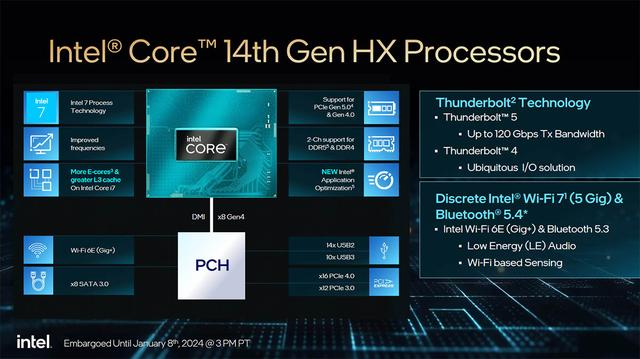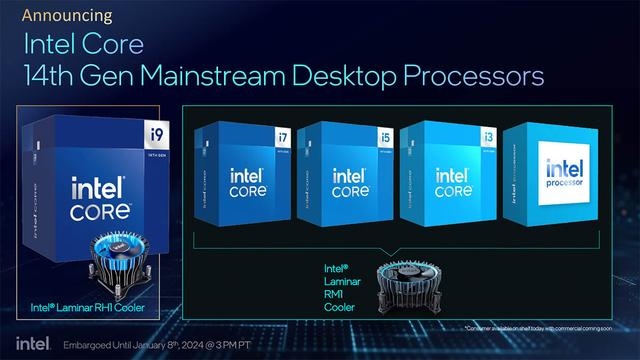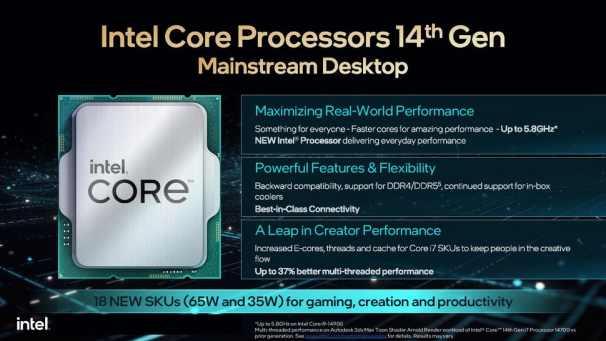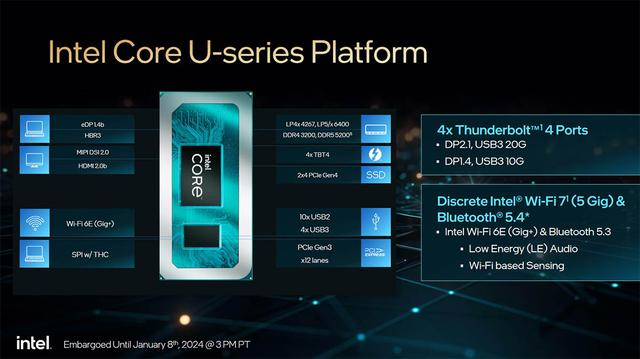
On January 9th, preceding CES 2024, Intel formally announced the release of its 14th generation Core processors for both mobile and desktop platforms. This includes the Core HX series for mobile devices and mainstream 65W and 35W processors for desktops. Simultaneously, Intel introduced the new Core U mobile processor 1 series tailored for high-performance ultrabooks.
· 14th Generation Core HX Series Mobile Processors:
Representing an evolution of the 13th generation Core HX series, the 14th generation Core HX series retains the original design and architecture while enhancing overall specifications. These processors achieve an unprecedented maximum frequency of 5.8GHz, claiming a 17% improvement in gaming performance and up to 51% in multitasking and creative capabilities.

Designed for gamers, creators, and professionals, the flagship model is the Core i9-14900HX, featuring 8P+16E, a total of 24 cores and 32 threads, and a maximum turbo frequency of 5.8GHz. It supports up to 192GB of DDR5-5600 memory, Thunderbolt 5, overclocking capabilities through Intel Extreme Utility (XTU) and Intel Extreme Memory Profile (XMP), and Intel Application Optimizer (APO).

In terms of connectivity, the 14th generation Core HX series mobile processors introduce the next-gen Thunderbolt 5, doubling bidirectional bandwidth to 80Gbps, with an option to reach up to 120Gbps. They also support Thunderbolt 4 40Gbps and come with Wi-Fi 6E (Gig+) and Bluetooth 5.3, with an option to support Wi-Fi 7 (5 Gig) and Bluetooth 5.4 through an external Killer 1750x card.

The lineup has been streamlined, reducing the number of models from 9 to 5 for easier identification and differentiation. While frequency and core count have increased in some models, the base power consumption remains at 55W, with a maximum turbo power consumption of 157W.
The 14th generation Core HX series mobile processors have already been incorporated into designs for over 60 laptops from major brands, including Acer, Alienware, Asus, Gigabyte, HP, Lenovo, MSI, and Razer.
· 14th Generation Core Desktop Mainstream Series:
Introducing a broader range of 65W and 35W mainstream models, comprising a total of 18 products, catering to users' everyday gaming, creative, and work needs.

The release includes 18 SKU models with standard versions (7 models), F series without integrated graphics (4 models), and T series low-power versions (7 models), covering i9, i7, i5, and i3 categories. All processors come with original cooling solutions, with i9 series featuring the advanced Laminar RH1, and others equipped with Laminar RM1.
The flagship i9-14900/F model boasts 8P+16E, 24 cores, 32MB L2 cache, 36MB L3 cache, and maximum turbo frequencies of 5.8GHz (P core) and 4.3GHz (E core). Comparing to the 13th generation Core i7-14700K, i7-14700/F/T models have increased core count, cache sizes, and accelerated frequencies.
The processors support up to 192GB of DDR5-5600 memory, along with DDR4-3200 memory, and are backward compatible with current Intel 600 and 700 series chipsets.
· Core U Mobile Processor 1 Series:
Intel also unveiled the Core U mobile processor 1 series, meeting the expectations of mainstream mobile PC users for lightweight laptops that balance efficiency and performance.

The Core i7-150U processor, for instance, features 2P+8E, a total of 10 cores and 12 threads, and a maximum turbo frequency of 5.4GHz. It supports up to 96GB of DDR5-5200 memory, Thunderbolt 4 for connectivity with 40Gbps bandwidth for multiple 4K displays and accessories. Additionally, it provides 8 PCIe 4.0 channels, 12 PCIe 3.0 channels, and supports Bluetooth 5.3/5.4.
Intel stated that laptops equipped with the Core U mobile processor 1 series are expected to be available in the first quarter of 2024.




